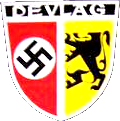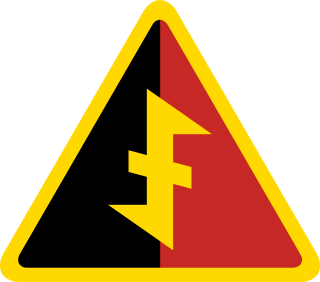
The National Socialist Movement in the Netherlands was a Dutch fascist and later Nazi political organisation that eventually became a political party. As a parliamentary party participating in legislative elections, the NSB had some success during the 1930s. Under German occupation, it remained the only legal party in the Netherlands during most of the Second World War.

The Rexist Party, or simply Rex, was a far-right Catholic authoritarian and corporatist political party active in Belgium from 1935 until 1945. The party was founded by a journalist, Léon Degrelle, It advocated Belgian unitarism and royalism. Initially, the party ran in both Flanders and Wallonia, but it never achieved much success outside Wallonia and Brussels. Its name was derived from the Roman Catholic journal and publishing company Christus Rex.

The Flemish Movement is an umbrella term which encompasses various political groups in the Belgian region of Flanders and, less commonly, in French Flanders. Ideologically, it encompasses groups which have sought to promote Flemish culture and the Dutch language as well as those seeking greater political autonomy for Flanders within Belgium. It also encompassed nationalists who seek the secession of Flanders from Belgium, either through outright independence or unification with the Netherlands.
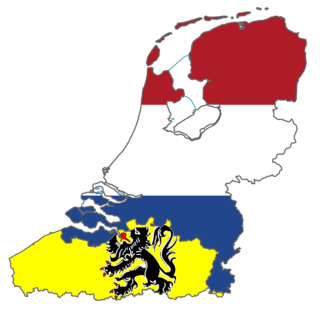
Greater Netherlands is an irredentist concept which unites the Netherlands, Flanders, and sometimes Brussels. Additionally, a Greater Netherlands state may include the annexation of the French Westhoek, Suriname, formerly Dutch-speaking areas of Germany and France, or even the ethnically Dutch and/or Afrikaans-speaking parts of South Africa, though such variants are mostly limited to far-right groups. A related proposal is the Pan-Netherlands concept, which includes Wallonia and potentially also Luxembourg.

The Vlaamsch Nationaal Verbond, widely known by its acronym VNV, was a Flemish nationalist political party active in Belgium between 1933 and 1945. It became the leading force of political collaboration in Flanders during the German occupation of Belgium in World War II. Authoritarian by inclination, the party advocated the creation of a "Greater Netherlands" (Dietsland) combining Flanders and the Netherlands.

The Flemish Legion was a collaborationist military formation recruited among Dutch-speaking volunteers from German-occupied Belgium, notably from Flanders, during World War II. It was formed in the aftermath of the German invasion of the Soviet Union and fought on the Eastern Front in the Waffen SS alongside similar formations from other parts of German-occupied Western Europe.

Verdinaso, sometimes rendered as Dinaso, was a small fascist political movement active in Belgium and, to a lesser extent, the Netherlands between 1931 and 1941.
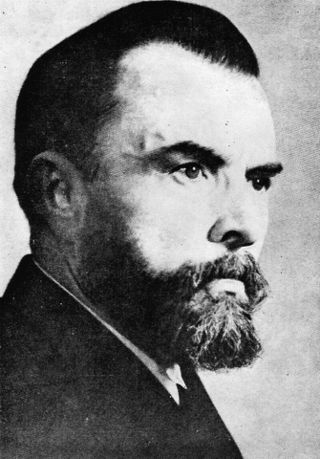
Staf De Clercq was a Flemish nationalist collaborator, co-founder and leader of the Flemish nationalist Vlaamsch Nationaal Verbond.
Flemish Sign Language is a deaf sign language of Belgium. It is closely related to French Belgian Sign Language, but they are now generally recognized as distinct languages. VGT is estimated to include around 6,000 sign-language users.
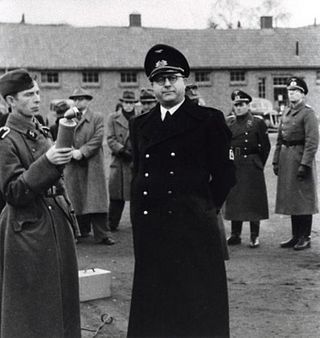
Hendrik Jozef Elias was a Belgian politician and Flemish nationalist, notable as the leader of the Vlaams Nationaal Verbond between 1942 and 1944.

Wies Moens was a Belgian literary historian, poet and Flamingant activist. He was also a founding member of the right-wing Verdinaso movement.

The Military Administration in Belgium and Northern France was an interim occupation authority established during the Second World War by Nazi Germany that included present-day Belgium and the French departments of Nord and Pas-de-Calais. The administration was also responsible for governing the zone interdite, a narrow strip of territory running along the French northern and eastern borders. It remained in existence until July 1944. Plans to transfer Belgium from the military administration to a civilian administration were promoted by the SS, and Hitler had been ready to do so until Autumn 1942, when he put off the plans for what was intended to be temporary but ended up being permanent until the end of German occupation. The SS had suggested either Josef Terboven or Ernst Kaltenbrunner as the Reich Commissioner of the civilian administration.
Fredegardus Jacobus Josephus (Jef) van de Wiele was a Belgian Flemish Nazi politician. During the Nazi occupation of Belgium he became notorious as the leader of the most virulently pro-Nazi wing of Flemish politics.

Cornelius Eduardus Hermans was a Belgian Flemish nationalist politician and writer.
The Frontpartij was a Belgian political party that campaigned for increasing recognition for the Flemish people and their language. Originating from the earlier Frontbeweging, the Frontpartij was an early attempt to fully politicise the Flemish Movement. In contrast to some of its successor movements the party supported democracy and autonomy rather than authoritarianism and independence.

The Reichskommissariat of Belgium and Northern France was a Nazi German civil administration (Zivilverwaltung) which governed most of occupied Belgium and northern parts of occupied France in the second half of 1944 during World War II.

The Special Forestry Platoon, nicknamed the woodchoppers of the Orne, was a non-combat penal military unit of the Belgian Army during World War I. As its name suggests, the unit specialized in forestry, specifically woodchopping, conducted as a form of penal labour.
The Flemish Guard was a collaborationist paramilitary formation which served as an auxiliary police in parts of German-occupied Belgium during World War II. It was founded as an independent formation in May 1941 at the initiative of the Union of Flemish Veterans and the Flemish National League. Both associated with the pre-war Flemish Movement, the VNV soon emerged as the largest collaborationist faction in Flanders during the occupation. In propaganda, the Flemish Guard was depicted as the police force of a future independent Flanders. It was distinct from the Flemish Legion, formed by the VNV in July 1941, to participate in the German invasion of the Soviet Union.
